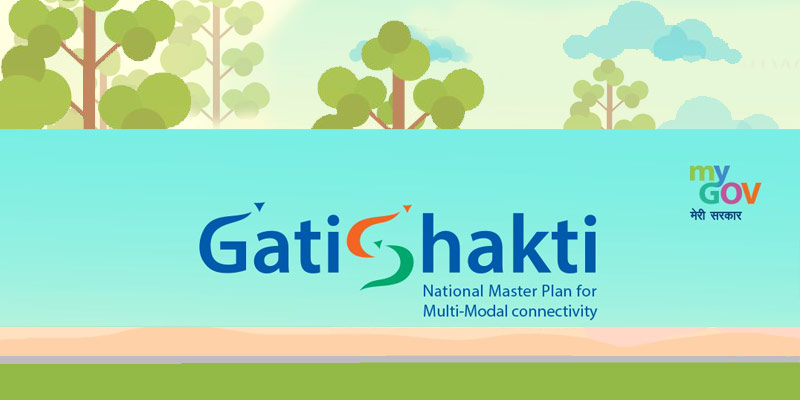- India
- Mar 19
PM Gati Shakti: 156 critical infra gap projects identified
As many as 156 critical infrastructure gaps to ports and for movement of bulk commodities such as coal, cement, fertilizers and foodgrains, have been identified for intervention under the PM Gati Shakti initiative.
The Network Planning Group (NPG) is constituted under the initiative.
So far, 44 Network Planning Group meetings held at the central level, wherein 66 major infrastructure projects worth Rs Rs 5 lakh crore, have been evaluated.
To facilitate wider adoption of the PM Gati Shakti National Master Plan, a series of regional workshops are being organized across all states/UTs.
These workshops aim to bring more vigour and build synergy among different stakeholders resulting in mutual learning among states/UTs and central ministries/departments.
PM Gati Shakti
• In October 2021, Prime Minister Narendra Modi launched a Rs 100 lakh crore Gati Shakti — national master plan for multi-modal connectivity that aims to develop infrastructure to reduce logistic costs and boost the economy.
• PM Gati Shakti targets to cut logistic costs, increase cargo handling capacity and reduce the turnaround time.
• Gati Shakti will bring ministries including railways and roadways together for integrated planning and coordinated implementation of infrastructure connectivity projects.
Significance of Gati Shakti
• Infrastructure creation in India had suffered for decades from multiple issues. There was a lack of coordination between various departments.
• For example, once a road was constructed, other agencies dug up the newly constructed road again for activities like laying of underground cables, gas pipelines, etc. This not only caused great inconvenience but was a wasteful expenditure.
• To address this, efforts were put in place to increase coordination so that all cables, pipelines, etc could be laid simultaneously.
• Steps have also been taken to address other issues like time-taking approval process, multiplicity of regulatory clearances, etc.
• PM Gati Shakti will address the past issues through institutionalising holistic planning for stakeholders for major infrastructure projects. Instead of planning and designing separately in silos, the projects will be designed and executed with a common vision.
• Logistics costs are 13 per cent that of India’s GDP. Due to this figure, the competitiveness of Indian exports decreases. India needs to strengthen its last-mile connectivity.
Gati Shakti is based on six pillars:
1) Comprehensiveness: It will include all the existing and planned initiatives of various ministries and departments with one centralised portal. Each and every department will now have visibility of each other’s activities providing critical data while planning and execution of projects in a comprehensive manner.
2) Prioritisation: Through this, different departments will be able to prioritise their projects through cross–sectoral interactions.
3) Optimisation: The national master plan will assist different ministries in planning for projects after identification of critical gaps. For the transportation of the goods from one place to another, the plan will help in selecting the most optimum route in terms of time and cost.
4) Synchronisation: Individual ministries and departments often work in silos. There is lack of coordination in planning and implementation of the project resulting in delays. PM Gati Shakti will help in synchronising the activities of each department, as well as of different layers of governance, in a holistic manner by ensuring coordination of work between them.
5) Analytical: The plan will provide the entire data at one place with GIS-based spatial planning and analytical tools having over 200 layers, enabling better visibility to the executing agency.
6) Dynamic: All ministries and departments will now be able to visualise, review and monitor the progress of cross-sectoral projects, through the GIS platform, as the satellite imagery will give on-ground progress periodically and progress of the projects will be updated on a regular basis on the portal. It will help in identifying the vital interventions for enhancing and updating the master plan.
Network Planning Group (NPG)
• An integrated multi-modal Network Planning Group (NPG) with heads of Network Planning Division of all connectivity infrastructure ministries and departments is responsible for unified planning and integration of the proposals.
• It will assist the empowered group of secretaries (EGOS), which is headed by the cabinet secretary. EGOS consists of secretaries of ministries as members and Head of Logistics Division, under the DPIIT, as member convenor.
• NPG will guide all the departments and ministries responsible for creation of economic zones and connectivity infrastructure during the planning phase itself.
• The coordination between ministries/departments is pivotal and the role of NPG is crucial to achieve the integration of infrastructure projects.
• The parameters/prescribed norms of the overall National Master Plan will be the overarching objective of the NPG for examining and sanctioning future projects thus leading to minimising disruptions and strive for the creation of an ideal and efficient operating system for all infrastructure projects in the country.
NPG’s role is to ensure:
i) Integration of networks.
ii) Enhance optimisation through modification/expansion/new network creation.
iii) Avoid duplication of works for holistic development of any region.
iv) Reduction logistics costs through micro-plan detailing.
Manorama Yearbook app is now available on Google Play Store and iOS App Store


